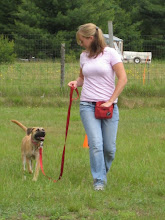Bringing your Newly Adopted Dog Home
By Miss Behavior CPDT-KA, Laura Chapman,
MissBehaviorTraining.com
One of the most important things in bringing your new dog home is having
patience. The transition takes time and while your family will want everything
to work as quickly as possible, our new dog and existing pets will need
anywhere from 2 weeks to 6 months to adjust.
Try to plan on bringing your new dog home when you have at least a full couple
of days to spare. You will need to keep a close eye on your new companion and
make sure all introductions to other family members progress smoothly so
bringing a dog home on a Monday night and taking off to work the next morning
is not smart.
Supplies to have ready at home:
Gate(s): so you can separate your new dog
from your existing pets
Crate: Big enough for your new dog to
stand up, lie down, turn around but not run marathons
Cleaner: Something specific to your dog
having accidents in the house. Household cleaners won’t serve the purpose as
they often have ammonia in them
Non-Slip/Martingale collar: This one if
important for safety reasons. This type of collar can’t slip over your dog’s
head if he panics and tries to back out of it
Flat leash: Not a retractable – they
are both dangerous and sometimes scary if you drop it mistakenly. They also
teach dogs that pulling on leash is encouraged (not an early message you want
to send!)
Treats: Some really good stuff that can
be used to encourage good habits such as going to the bathroom outside, lying
down, sitting for greeting, introductions, etc
Kong: This can be stuffed with kibble,
treats, peanut butter, etc for alone time
Introducing your new dog to your current family:
Once they are ready to come into the house together, use gates to give
them breaks from each other. Be a good parent who enforces breaks. Over tired
dogs can get cranky or can lose control of their impulses so even if all seems
well, separate them for periods of time. This may need to continue for a couple
of weeks. The dogs should not be left home alone together. The new dog should
go through the crate training process. Leave your new dog alone in his crate
(after properly introducing the crate) whether you are home or not. It’s
critical that you teach your dog that you will leave for short periods of time,
you will leave him with something to do or chew, and you WILL be back. Dogs who
spend too much time with their new family and little time alone have a hard
time coping with being left alone later on. This is the #1 cause of separation
anxiety!
If you have a cat, take it very slow. Rub both the dog and cat down with
a towel and switch them so they can get each other’s scent. Your cat should
have an escape. Use gates. Put food up high or in his safe room. This is also
where the litter box should go. Kitties who feel threatened often find
alternative litter boxes!
Please consult a professional if your new
or current pets show signs of distress or aggression, or for more in-depth information on introducing your new pet to your current family!
Visit APDT.com for a list of local
behavior consultants







